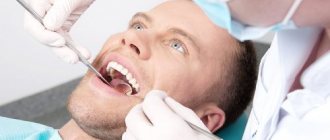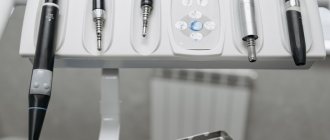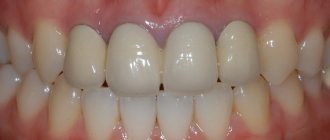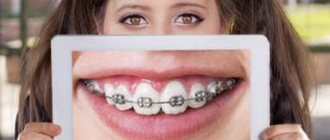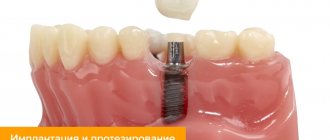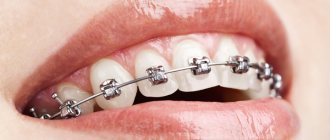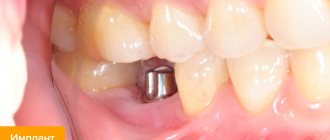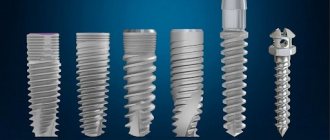28.10.2019
Removing or extracting a tooth is an unpleasant procedure. After the operation, tissue healing awaits. How many days will it take for the sutures to be removed from the gums, what can and cannot be done before and after removal of the sutures - such questions torment patients.
Content:
- Why is the wound sutured after pulling out the figure eight?
- Classification of seams
- How long do you need to walk with non-absorbable sutures?
- How long does it take for self-absorbable sutures to dissolve?
- What complications can you encounter after suturing?
- Recommendations for patients
A dental surgeon applies sutures after removing a wisdom tooth if the intervention was very complex and serious injury to the gums occurred.
Often, specialists insist on suturing a wound, even if it is small, in order to minimize the likelihood of infection. Let's consider what material doctors use when suturing after tooth extraction, whether it needs to be removed in the future, and how to properly care for the injured area.
Precautionary measures
If you feel severe pain or see blood while removing a suture, stop immediately. This means that the wound has not yet healed and it is dangerous to touch it, otherwise the edges will separate. Pain, tissue inflammation, suppuration or increased temperature after removal of the threads are a dangerous sign. It indicates that the tissue has become infected and requires immediate medical attention.
We categorically do not recommend removing stitches at home, especially if you are not confident in your abilities. Contacting specialists Dr. Mos will relieve you of discomfort and unwanted consequences of the procedure.
Author: Ph.D. surgeon Samsonova G.S.
Why is the wound sutured after pulling out the figure eight?
Wisdom teeth are very insidious and often lead to serious problems. Pulling it out most often resembles an operation. Since the roots of the unit go deep into the gum and can be ornate, tortuous, soft tissue is often excised to extract them. After all solid debris has been removed from the depths of the tissue, the wound is sutured. This is done in order to:
- prevent bleeding;
- protect the blood clot formed in the wound from injury;
- protect the operated area from the accumulation of food debris;
- minimize the risk of damage to the operating area;
- speed up regeneration processes.
It is believed that applying sutures after wisdom tooth removal reduces the likelihood of infection by approximately 90%. This is explained by the fact that pathogens cannot penetrate into the deep layers of the wound.
Why are sutures required after wisdom tooth removal?
Extraction of the third molar requires suturing. It is not always possible to save the patient from the procedure described above. Even when working with high-quality equipment, a competent dentist will encounter problems. The third molar is secured with the help of two roots, the removal of which requires making a few incisions, and then removing the tooth body from the gum. Sutures are also applied if there are clinical signs of gum inflammation. Swelling is considered a natural process for the body, due to damage to the gums during incisions. The suturing procedure is also a preventive measure, which reduces the risk of infectious pathological syndrome; pathogenic bacteria do not penetrate into the open wound. The smaller the size of the wound, the lower the likelihood of infection, the age the rate of regeneration. Regardless of the type of thread used, suturing takes a short period of time. Self-absorbable threads are a more preferable option; they do not need to be removed and re-injure the gums.
Classification of seams
After tearing out the “eight”, at the discretion of the dental surgeon, regular and self-absorbing sutures can be applied.
In the first case, we are talking about materials that cannot dissolve on their own. These are silk, nylon, polyester. Such threads are not absorbed. They securely hold the edges of the wound until the doctor removes them. Self-absorbable material is absorbable. Its main advantage is that the patient does not have to visit the doctor again to have his stitches removed. The latter disappear without a trace on their own.
There are two types of self-absorbable threads:
- Absorbable due to hydrolysis reaction. These include Dexon and Vicryl threads. They are synthetic and do not cause allergic reactions. The edges of the wound are securely held for about one month.
- Absorbable due to the influence of enzymes. We are talking about Catgut. Its particles are quickly eliminated from the human body. Catgut is used for complex dental operations. But it is important to consider that it contains foreign proteins that can cause inflammation.
There is no need to think that suture materials dissolve without a trace. They simply break down into tiny particles that a person spits out or swallows. These particles are non-toxic and therefore cannot cause poisoning.
Types of seams. Types of threads
In each case, when the dental surgeon sutures the gum, he decides which suture to use.
Seams can be intermittent or continuous.
The first type is more common and is characterized by the overlapping of separate, unrelated stitches (pictured below), and each is secured with its own knot.
This maintains the integrity of the fabrics, even if one of the stitches fails and falls off.
There is continuous suturing. All stitches are made with a single suture thread, securing them with a common knot. It's faster, but any damage to one stitch can ruin the entire thread construction.
Absorbable and non-absorbable threads are used to suture the gums.
Sutures that dissolve
Natural (Catgut) and synthetic (Vicryl, Dexon) threads are used. When suturing the gums with Catgut, it can stay on the wound for at least 2 weeks. It is dissolved by saliva substances, but due to its protein base it often causes allergies with inflammation of the gums.
Catgut is contraindicated if there is a high risk of inflammatory complications. Dental surgeons are using this material less and less.
Synthetic Vicryl is safe in terms of tolerability, adheres tightly to the gum, and does not change its strength properties during disinfection. If the doctor does not prescribe a time limit for removing the threads, they will still dissolve within 3 months.
Dexon will last on the gums a little longer than Vicryl, otherwise their properties are similar.
No one can say for sure how long it takes for threads to dissolve in a particular patient. This depends on individual factors: characteristics of the wound, the chemical environment of the oral cavity, general immunity, and the patient’s hormonal status.
When absorbed, the thread does not disappear without a trace, but gradually disintegrates into particles, which are spat out or swallowed by the patient. It is not dangerous to health.
Threads that do not dissolve
Non-absorbable threads are nylon, silk, polyamide fiber (nylon). Synthetic threads are completely hypoallergenic.
Sutures made from non-absorbable sutures are called non-absorbable or non-absorbable sutures. Their removal after the stitches have healed is mandatory. If such threads are used and there are no complications, the surgeon will release the patient from them 7–10 days after the tooth has been pulled out or another operation on the gums has been performed.
How long do you need to walk with non-absorbable sutures?
If the doctor used non-absorbable suture material after removing a wisdom tooth, then seven to ten days later the patient must return for an appointment. The doctor will evaluate how the wound is healing and determine whether the suture material can be removed.
There is no need to be afraid of this procedure. It causes only minor discomfort. The dentist cuts the stitches one by one and, grasping one end of the thread with tweezers, carefully pulls it out. If the patient is afraid of pain, the doctor may use topical anesthesia.
Hygienic oral care after suture removal
To quickly restore the integrity of the soft tissue of the oral cavity, the patient must:
- Use a soft toothbrush to brush your teeth daily;
- use anti-inflammatory rinses;
- rinse the mouth with warm water or a decoction of medicinal herbs after each meal;
- Avoid eating hard, sour, salty, spicy foods that can irritate the mucous membrane.
Timely removal of sutures, maintaining oral hygiene, and performing procedures prescribed by the dentist will ensure good wound healing and speed up recovery.
How long does it take for self-absorbable sutures to dissolve?
Typically, the suture material disintegrates after three weeks. The patient may notice how it has fallen out, or simply find that the wound remains clean, without threads. In more detail, catgut dissolves from ten to fourteen days, Vicryl - within thirty days, Dexon - a little longer.
It is impossible to name the exact period of resorption. Here everything depends not only on the characteristics of the material used, but also on the individual characteristics of the patient’s body. It also happens that the threads are still in place, but the doctor no longer sees the need for them. Then he removes them in the same way as non-absorbable ones.
Materials used in osteoplasty
Osteoplasty uses both natural implants and artificial ones (allosynthetic materials). Natural ones include:
- Autogenous grafts are those that were taken from the same patient and transplanted into him. This material survives better than all other grafts, but you need to understand that another operation will be performed to remove tissue from the donor site.
- Allografts are material that has been taken from a donor's dead body for medical purposes. The material is carefully processed, disinfected, it perfectly restores bone tissue and is used in osteoplasty with great success.
- Xenografts are material taken from certain species of animals and corals. It is also carefully processed, sterilized and prepared for further use in invasive dental procedures associated with implantation.
Synthetic (alloplastic) implants are made on the basis of calcium phosphate or hydroxyapatite; they are also widely used by all specialists around the world.
What complications can you encounter after suturing?
- As a rule, the regeneration process proceeds without complications. But it happens that the patient encounters symptoms that bother him. Let's name the most common complications after wisdom tooth removal:
- Bleeding. In the first three days after surgery, periodic bleeding is considered normal, but if bleeding persists longer, you should immediately consult a dental surgeon.
- Three days after removal, the gums look very swollen and very painful. You need to make sure that all roots have been removed. To do this, pictures of the inflamed area are taken.
- Increased temperature several days after surgery. If the hole bleeds, is swollen and hurts, and the body temperature is elevated, we can talk about inflammation of the surgical area. To remove it, you need to carry out antibiotic therapy.
If you have the slightest doubt regarding the healing process, you should immediately see a qualified dentist. Very often, delay makes the situation worse. It is better to get a consultation once again than to treat an advanced complication for a long time.
How to remove stitches at home
If you want to remove stitches yourself, follow two key rules - neatness and hygiene. Be sure to prepare for the procedure and reserve time - rushing in such a matter can cause unpleasant consequences.
Preparation and tools
Removing stitches after surgery requires a set of tools: you will need sharp scissors (surgical or nail clippers), tweezers, sterile bandages, antiseptic or alcohol, soap and a clean towel. The knife will not work - it may slip and you will injure yourself.
Boil the instruments well and wipe them with disinfectant liquid, wash your hands thoroughly. Wipe the area where manipulation will be performed with an antiseptic or alcohol.
Procedure
Find a well-lit area - removing stitches in the dark is dangerous. Sit comfortably so that the wound is clearly visible, then follow these steps:
- pick up the first knot with tweezers, lift it slightly and cut the thread, being careful not to touch the wound;
- carefully pull out the suture material, but so that only clean pieces of thread pass through the fabric;
- do not try to pull the knots through the tissue - they will get stuck and cause bleeding;
- keep cutting and pulling the threads until you get rid of them completely.
There should be no pain, but slight discomfort is possible. After removing the suture, make sure that there is no residual material left in the wound. Wipe it again with alcohol, apply a sterile bandage or cover with a bandage. To prevent infection, it is advisable to treat the surface with antibiotic ointment.
The strength of the tissues after the sutures are removed is low, so protect the wound from damage, sun, cold and dirt. Check the surface of the skin daily to make sure the healing process is going well.
Recommendations for patients
To ensure that the recovery process takes little time and goes without complications, it is recommended:
- Follow all doctor's orders.
- Do not eat anything for the first few hours after surgery. In the first two to three days after therapy, chew food with the healthy side of the jaw and give preference to soft foods.
- Do not touch the unhealed hole with your hands.
- Do not try to remove a blood clot with your tongue or foreign objects.
- Rinse only if prescribed by a doctor.
- Avoid strenuous physical activity for the first two weeks.
- Do not attempt to remove stitches yourself.
By following these simple rules, a person can quickly return to their normal lifestyle after dental surgery.
Why are sutures placed on the gums?
Most often, such a manipulation is carried out when removing a molar or a painful “eight”. In half of the cases, if there are large branches and the nerve is deep, the dentist has to cut the gum. This leaves a large hole or wound that bleeds and can easily become infected. By applying several neat stitches, the specialist tries to prevent possible complications:
- entry of dangerous microbes and microorganisms into the cut;
- improvement of socket fusion;
- decreased blood secretion;
- prevents particles of food and liquid from penetrating into the inflamed area.
Observations and studies show that when suturing an injured gum, the risk of unpleasant consequences is reduced to only 10%. This greatly simplifies daily handling and hygiene. It is important for the doctor to reduce the operated area to a minimum so that pathogenic microflora does not provoke sepsis and periodontal necrosis.
There is a slight difference in what kind of sutures the dentist places on the gums: regular and self-absorbing. The latter are most effective for use in the oral cavity, where there is a large amount of saliva. The optimal material for such work:
- Catgut: has long been used in any field of medicine. It stays well on the mucous membrane for at least 10–14 days. Natural amino acids gradually dissolve the thread and leave no trace. The only problem is the protein base of the material. Some patients experience a negative reaction and even inflammation to this protein, so dentists are using it less and less in their practice.
- Vicryl: a more modern and completely synthetic material that is absolutely safe for the patient due to its hypoallergenicity. It tightly holds the edges of the hole in the required position, is easy to disinfect and retains its properties for 3–4 months. If there is no exact time limit for removing the sutures on the gums, you should not worry: they will definitely dissolve under the influence of moisture.
When a fistula forms on the mucous membrane or a painful lump occurs, only a specialist decides how the operation will be performed and what types of threads need to be used.
Possible complications
Pain and swelling of the gums at rest, difficulty chewing, evening fever in the first two days after surgery and suturing are considered normal - this is a response to surgical trauma. If the symptoms increase, it means that a purulent complication is developing. A visit to the doctor is needed, opening the wound with removal of the suture threads, washing it, re-suturing or draining it, and taking antibiotics.
Complications arise when wound hygiene is not observed, infection occurs, or particles of a tooth or root are left in the wound.
Continued bleeding from the surgical area is possible if the stitches come apart.
Seam divergence
If the suture breaks apart after tooth extraction, this may indicate inflammation of the periosteum - periostitis.
When infected, the wound area swells, there is pain, discharge of pus, which can push out the threads, and the edges of the tissue diverge. Healing is delayed, and there is a risk of developing ugly scars.
If the sutures on the gums come apart, it is necessary to visit a surgeon to determine the cause and eliminate it with re-suturing of the wound in the oral cavity.
What to do if the suture breaks after implantation
There are times when the threads have weakened and come apart. This does not threaten the implant falling out, but there is a risk of infection . The situation must be corrected urgently.
After the examination, the doctor will take the necessary antiseptic measures and prescribe rinses. The recovery period after long complex operations is sometimes accompanied by antibiotic therapy. The rehabilitation course for each patient is compiled individually. If the tissues have not yet fused, the specialist will have to remove the stitches and then apply new ones.
Does it hurt to remove stitches?
It all depends on the pain threshold and sensitivity of the patient. But usually the wound manages to heal within the specified time; if the doctor works professionally and quickly, then the person does not feel any pain. If sensitivity is high, the doctor may administer a mild form of anesthesia that will calm the patient. During surgery, some people simply do not have the patience to wait for the doctor to remove all the suture fragments.
It happens that the tooth sits so deep that it takes a long time and carefully to remove the threads. In any case, if you want anesthesia, then the doctor, in the absence of contraindications, must agree to give it to you. Another thing is that in free clinics this anesthesia may not greatly affect sensitivity, and you will still feel some discomfort. But everyone has their own choice.
The removal procedure is quite simple: the doctor cuts the threads with special scissors and removes their remains with tweezers. When pus appears, the threads are removed immediately, and then the wound is disinfected and sutured again.
Important! A week after the operation, visit the doctor, but if you feel that the stitches have come apart earlier or that pus has formed, then immediately go to a specialist.
When to remove gum sutures
After complex manipulations, the patient should carefully follow all the surgeon’s instructions. Typically, complete healing and restoration of soft tissues takes at least 7-10 days. During this period, the wound and sutures are treated with antiseptics, lubricated with special solutions and ointments to improve blood circulation (Acepta, Metrogyl Denta, Solcoseryl). Sometimes antibiotics are required to treat possible health complications.
The final decision on when to remove the sutures on the gums is made differently in each case. Healing occurs in patients purely individually and depends on age, hormonal levels and general immunity. Threads can be removed if the following positive changes are observed upon visual inspection:
- the mucous membrane is not swollen and has no signs of suppuration;
- the person does not have shooting pain, fever or itching inside the jaw;
- there is no discharge or unpleasant odor from the wound when pressed;
- periodontal tissues have a uniform pink color.
When using self-absorbable material, in most cases the specialist still removes the threads and does not leave them for a long period. If you do this before a clot forms in the socket, inflammation may begin. The dentist will need to open the inflamed area, clean it again, and apply new stitches.
